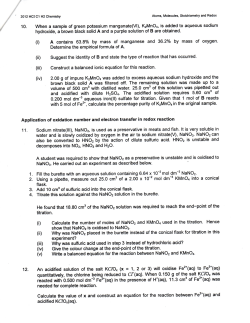
Exam IV Sample Problems S 1. The entropy change in a system (
Exam IV Sample Problems 1. The entropy change in a system (ΔSsys) _____ during a spontaneous process. a. is positive b. is negative c. is zero d. All three of the above answers are possible. 2. (3 points) ΔSsurroundings is related to heat (enthalpy) in the system by: c. –qsys/T = ΔSsurr a. –q /T = ΔS surr surr b. qsys/T = ΔSsurr d. qsurr/T = ΔSsurr 3. If 3.500 g of Ni are reacted with excess oxygen to form nickel oxide (NiO), what is the standard entropy change for the reaction? 2 Ni(s) + O2(g) Substance 2 NiO(s) S° (J/mol · K) Ni(s) 182.1 O2 (g) 205.0 NiO(s) 37.99 4. At what temperature (K) is the given reaction at equilibrium? Assume ΔH° and S° do not change with temperature. 2 NO2(g) N2O4(g) given Substance NO2(g) N2O4(g) 5. ΔH° (kJ/mol) 33.2 9.2 S° (J/mol · K) 240.0 304.2 (3 points) Boltzmann derived the relationship, S = klnW where W is: a. the number of microstates. c. kinetic energy. b. vibrational energy. d. potential energy. 6. A molecule of chlorine has energy microstates involving _____, _____, and _____ modes of motion. a. translational, rotational, kinetic energy b. kinetic energy, potential energy, translational c. rotational, vibrational, potential energy d. translational, rotational, vibrational 7. If 1 mol of ice melts at its melting point of 273 K, the entropy change for the ice is 22.0 J/K. If the ice melts in someone’s hand at 34°C, what is the change in the entropy of the universe? The enthalpy of fusion for ice is 6.01 kJ/mol. 8. A reaction A(g) → B(g) + C(g) has the following standard thermodynamic parameters: ΔH°r×n = 40.0 kJ/mol and ΔS°r×n = 80.0 J/mol ·K. a. Is the reaction exothermic or endothermic? b. Does the positive entropy change make sense? Why? c. Is the reaction spontaneous at all temperatures? If not, explain. d. If the answer to part (c) is “no”, then calculate the temperature at which the reaction becomes spontaneous. 9. Processes with _____ and _____ are always spontaneous. a. ΔH > 0 and ΔS < 0 c. ΔH > 0 and ΔS > 0 b. ΔH < 0 and ΔS < 0 d. ΔH < 0 and ΔS > 0 10. (4 pts) Determine the pH and pOH of 0.250 L of a buffer that is 0.0250 M boric acid and 0.0200 M sodium borate; pKa1 for H3BO3 = 9.00 at 25°C. 11. (3 pts) Which of the following salts forms aqueous solutions with pH = 7? c. NaClO2 a. Na S 2 b. NaBr d. NaNO2 12. (4 points) In the following reaction, which species is the Lewis acid? Cu2+ + NH3 a. Cu2+ b. NH3 13. Cu(NH3)2+ c. [Cu(NH3)]2+ d. None of these is an acid. (5 points) Some scientists have proposed adding Fe(III) compounds to large expanses of the open ocean to promote the growth of phytoplankton that would in turn remove CO2 from the atmosphere through photosynthesis. The average pH of open ocean water is 8.1. What is the maximum value of [Fe3+] in pH 8.1 seawater if the Ksp value of Fe(OH)3 is 1.1 E-36? 14. (5 points) Calculate the molar solubility and pH of a saturated solution of Al(OH)3. Ksp(Al(OH)3)=1.9E-33. (HINT: What is the concentration of OH- in pure water?) 15. (4 points) Which of the following compounds will give a saturated solution with the highest concentration of iodide ions (I-)? (a) BiI3; Ksp = 8.1 x 10-19 (b) AuI; Ksp = 1.6 x 10-23 (c) AgI; Ksp = 1.5 x 10-16 (d) CuI; Ksp = 5.1 x 10-12 (e) AuI3; Ksp = 1.0 x 10-46 16. (5 points) For MgF2 (Ksp = 6.4 x 10-9), if you mix 400. mL of 1.00 x 10-4 M Mg(NO3)2, and 500. mL of 1.00 x 10-4 M NaF, what will be observed? (a) A precipitate forms because Qsp > Ksp. (b) A precipitate forms because Qsp < Ksp. (c) No precipitate forms because Qsp = Ksp. (d) No precipitate forms because Qsp > Ksp. (e) No precipitate forms because Qsp < Ksp. 17. (5 points) Suppose a saturated solution of barium fluoride contains 1.5 × 10–2 M F–. What is the Ksp value of BaF2? 17. (4 points) Glancing at a periodic table, where do you expect to find elements that are good oxidizing agents? a. on the right (except for extreme right) c. in the middle b. on the left 18. d. at the bottom (4 points) Which of the following reagents would you add to increase the water solubility of magnesium hydroxide? (a) MgCl2 (b) Mg(OH)2 (d) NaOH (e) H2O 19. (c) H2SO4 (4 points) In the smelting of iron from iron oxide according to the equation Fe2O3(s) + 3 CO(g) + 2 Fe(s) + 3 CO2(g) a. +3 b. –3 what is the change in oxidation number for iron? c. +2 d. –2 Miscellaneous Information and Formulae: R = 0.082057 L⋅atm/(mole⋅K) = 8.314 J/(mole⋅K) NA = 6.0221E23/mole 1 Faraday (F) = 9.6485E4 coulombs (C)/(mol⋅e−) 1 C⋅V = 1 J ΔG = −n٠F٠(Ecell) 1 amp (A) = 1 C/sec Ecell = E°cell – (R⋅T/n⋅F)⋅(ln Q) or at 298 K Ecell = E°cell – (0.0257V/n)٠ln(Q) Ecell = E°cell – (0.0592/n)⋅(log10 Q) (when converted from natural log) pH = -log[H+] pH + pOH = 14.00 (25°C) pH = pKa + log ([conj.base]/[acid]) ΔG = ΔGo + RT•ln(Q)
© Copyright 2025





















